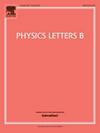Cluster production and the chemical freeze-out in expanding hot dense matter
IF 4.5
2区 物理与天体物理
Q1 ASTRONOMY & ASTROPHYSICS
引用次数: 0
Abstract
We discuss medium effects on light cluster production in the QCD phase diagram by relating Mott transition lines to those for chemical freeze-out. In heavy-ion collisions at highest energies provided by the LHC, light cluster abundances should follow the statistical model because of low baryon densities. Chemical freeze-out in this domain is correlated with the QCD crossover transition. At low energies, in the nuclear fragmentation region, where the freeze-out interferes with the liquid-gas phase transition, self-energy and Pauli blocking effects are important. We demonstrate that at intermediate energies the chemical freeze-out line correlates with the maximum mass fraction of nuclear bound states, in particular α particles. In this domain, the HADES, FAIR and NICA experiments can give new insights.
星团的产生和化学物质在膨胀的热致密物质中冻结
我们通过将莫特过渡线与化学冻结线联系起来,讨论了介质对QCD相图中光团产生的影响。在由大型强子对撞机提供的最高能量的重离子碰撞中,由于重子密度低,轻星系团丰度应该遵循统计模型。该区域的化学冻结与QCD交叉跃迁有关。在低能,在核碎裂区,冻结干扰液气相变,自能和泡利阻塞效应是重要的。我们证明,在中间能量,化学冻结线与核束缚态的最大质量分数相关,特别是α粒子。在这一领域,HADES、FAIR和NICA实验可以提供新的见解。
本文章由计算机程序翻译,如有差异,请以英文原文为准。
求助全文
约1分钟内获得全文
求助全文
来源期刊

Physics Letters B
物理-物理:综合
CiteScore
9.10
自引率
6.80%
发文量
647
审稿时长
3 months
期刊介绍:
Physics Letters B ensures the rapid publication of important new results in particle physics, nuclear physics and cosmology. Specialized editors are responsible for contributions in experimental nuclear physics, theoretical nuclear physics, experimental high-energy physics, theoretical high-energy physics, and astrophysics.
 求助内容:
求助内容: 应助结果提醒方式:
应助结果提醒方式:


